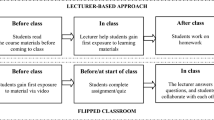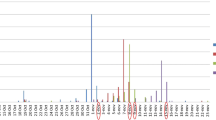Abstract
Using the method of design-based research, this study examines the three-year application of the modified flipped classroom model in a postgraduate course on learning sciences. In the modified flipped classroom, students form learning communities in groups. Before class, they read literature, raise questions, and discuss material both online and offline; in class, in an innovative modification to the traditional flipped classroom, students in the teaching group deliver content to their classmates and organize classroom activities; and after class, students conduct empirical research and complete research reports in groups. Through qualitative and quantitative analysis, it is found that the modified flipped classroom can effectively bring out students’ initiative and improve both their learning satisfaction and empirical research abilities. Group-based lesson design and empirical research are found to be the most rewarding activities for students. Finally, recommendations for the application of the modified flipped classroom to postgraduate teaching in the areas of learning platform, course content, teaching methods, and teacher–student interaction are proposed.
Similar content being viewed by others
References
Albert, M., & Beatty, B. (2014). Flipping the classroom applications to curriculum redesign for an introduction to management course: Impact on grades. Journal of Education for Business, 89, 419–424.
Barab, S. (2014). Design-based research: A methodological toolkit for engineering change. In R. K. Sawyer (Ed.), The Cambridge handbook of the learning sciences. Cambridge: Cambridge University Press.
Bloom, B. S. (1984). Taxonomy of educational objectives. Boston: Allyn and Bacon.
Cobb, P., Confrey, J., Lehrer, R., & Schauble, L. (2003). Design experiments in education research. Educational Researcher, 32(1), 9–13.
Collins, A. (1992). Toward a design science of education. In E. Scanlon & T. O’Shea (Eds.), New directions in educational technology. New York: Springer.
Collins, A., Joseph, D., & Bielaczyc, K. (2004). Design research: Theoretical and methodological issues. The Journal of the Learning Sciences, 13(1), 15–42.
Davies, R. S., Dean, D. L., & Ball, N. (2013). Flipping the classroom and instructional technology integration in a college-level information systems spreadsheet course. Educational Technology Research and Development, 61(4), 563–580.
Ferreri, S., & O’Connor, S. K. (2013). Redesign of a large lecture course into a small-group learning course. American journal of pharmaceutical education, 77(1), 1–9.
Gilboy, M. B., Heinerichs, S., & Pazzaglia, G. (2015). Enhancing student engagement using the flipped classroom. Journal of nutrition education and behavior, 47(1), 109–114.
Hoffmann, S. (2014). Beyond the flipped classroom: Redesigning a research methods course for e3 instruction. Contemporary Issues in Education Research, 7(1), 51–62.
Hung, H. T. (2015). Flipping the classroom for English language learners to foster active learning. Computer Assisted Language Learning, 28(1), 81–96.
Kim, M. K., Kim, S. M., Khera, O., & Getman, J. (2014). The experience of three flipped classrooms in an urban university: An exploration of design principles. The Internet and Higher Education, 22, 37–50.
Martin, S., Farnan, J., & Arora, V. (2013). FUTURE: New strategies for hospitalists to overcome challenges in teaching and today’s wards. Journal of Hospital Medicine, 8(7), 409–413.
Mason, G., Shuman, T., & Cook, K. (2013). Comparing the effectiveness of an inverted classroom to a traditional classroom in an upper-division engineering course. IEEE Transactions on Education, 56(4), 430–435.
McLaughlin, J., LaToya, G., Esserman, D., Davidson, C., Glatt, D., Roth, M., et al. (2013). Instructional design and assessment: Pharmacy student engagement, performance, and perception in a flipped satellite classroom. American Journal of Pharmaceutical Education, 77(9), 1–8.
Missildine, K., Fountain, R., Summers, L., & Gosselin, K. (2013). Flipping the classroom to improve student performance and satisfaction. Journal of Nursing Education, 52(10), 597–599.
O’Flaherty, J., & Phillips, C. (2015). The use of flipped classrooms in higher education: A scoping review. The Internet and Higher Education, 25, 85–95.
Trilling, B., & Fadel, C. (2009). 21st century skills: Learning for life in our times. San Franciso: Joessy-Bass.
Tune, J. D., Sturek, M., & Basile, D. P. (2013). Flipped classroom model improves graduate student performance in cardiovascular, respiratory, and renal physiology. Advances in Physiology Education, 37(4), 316–320.
Wilson, S. (2014). The flipped class: A method to address the challenges of an undergraduate statistics course. Teaching of Psychology, 40(3), 193–199.
Xiong, L., Xiong, F., Li, Z., & Xie, M. L. (2010). Exploration and analysis of the teaching quality assurance system of full-time postgraduates. Journal of Higher Education Research, 33(1), 51–54.
Yeung, K., & O’Malley, P. J. (2014). Making ‘the flip’work: barriers to and implementation strategies for introducing flipped teaching methods into traditional higher education courses. New Directions, 10(1), 59–63.
Young, T., Bailey, C., Guptil, M., Thorp, A., & Thomas, T. (2014). The flipped classroom: A modality for mixed asynchronous and synchronous learning in a residency program. Western Journal of Emergency Medicine, 15(7), 939–944.
Yuan, B. T., Zhao, W., & Wang, S. Y. (2007). Investigation and research on the status quo of China’s postgraduate education quality. Researches in Higher Education of Engineering, 4, 105–110.
Acknowledgements
This study was funded by the 2015 Comprehensive Discipline Construction Fund of Faculty of Education, Beijing Normal University.
Author information
Authors and Affiliations
Corresponding author
Rights and permissions
About this article
Cite this article
Chiang, FK., Chen, C. Modified Flipped Classroom Instructional Model in “Learning Sciences” Course for Graduate Students. Asia-Pacific Edu Res 26, 1–10 (2017). https://doi.org/10.1007/s40299-016-0321-2
Published:
Issue Date:
DOI: https://doi.org/10.1007/s40299-016-0321-2




